1. 背景介绍
1. Background
西北工业大学仿生芯片交叉研究中心成立于2020年12月,是计算机学院发起成立的首批三个交叉研究中心之一。结合国家“十四五”规划”和“二〇三五年远景目标”提出的“加快壮大新一代信息技术”和“发展战略新兴产业”的目标,以及国家关于《新一代人工智能发展规划》、《新时期促进集成电路产业和软件产业高质量发展的若干政策》等战略需求,面向世界科技前沿,服务创新型国家建设,对引领人工智能技术优势和培养未来拔尖创新人才具有重要意义。
The Interdisciplinary Research Center of Bio-inspired System-on-Chip (CBSOC) of Northwestern Polytechnical University was established in December 2020. It is one of the first three interdisciplinary research centers initiated by the School of Computer Science. Combining the goals of "accelerating the growth of new generation information technology" and "developing strategic emerging industries" proposed in the national "14th Five Year Plan" and "2035 Long Range Goals", as well as the strategic needs of the country such as the "New Generation Artificial Intelligence Development Plan" and "Several Policies to Promote the High Quality Development of the Integrated Circuit Industry and Software Industry in the New Era", facing the frontier of world science and technology and serving the construction of an innovative country. It is of great significance to lead the advantages of artificial intelligence technology and the education of innovative talents in the future.

图1 中心LOGO
Figure 1 the LOGO of the center
该中心面向仿生芯片前沿交叉领域,通过融合计算机科学、人工智能、集成电路、电子工程、生命科学、空间科学等多学科理论和方法,探索仿生感知、仿生计算与硅基/碳基芯片相结合的新型人工智能芯片关键技术,构建先进的仿生计算机系统,进一步提升人工智能系统的性能,解决航空、航天、航海、国防和生命健康等领域的重大需求。
This center is oriented towards the cutting-edge interdisciplinary field of bio-inspired chips. By integrating theories and methods from multiple disciplines such as computer science, artificial intelligence, integrated circuits, electronic engineering, life sciences, and space science, it explores key technologies for next-generation artificial intelligence chips that combine bio-inspired sensing, bio-inspired computing, and silicon/carbon-based chips. It constructs advanced bio-inspired computer systems, further improves the performance of artificial intelligence systems, and meets significant requirements of aviation, aerospace, navigation, national defense, and life and health.
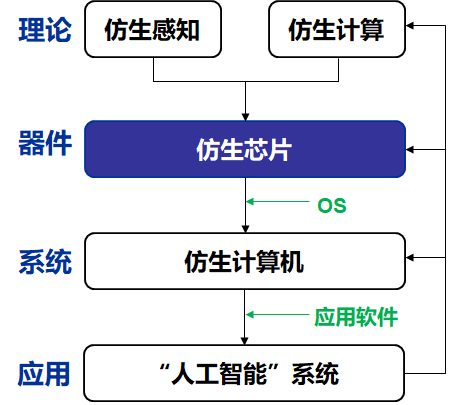
图2 仿生芯片内涵及应用设想
Figure 2 the concept of bio-inspired chip and applications
2. 主要研究方向
2. Main Research Directions
主要研究方向包括:仿生感知和仿生计算的基础理论、仿生材料与器件、仿生感知芯片、仿生计算芯片、集成电路设计与电子设计自动化等。
● 仿生感知和仿生计算的基础理论:模拟进化计算、人工神经网络、模糊逻辑与模糊推理等基础理论;蚁群算法、微粒群算法、人工蜂群算法、微分进化算法、文化算法、Memetic算法、人工免疫算法等仿生算法;
● 仿生材料与器件:忆阻器、铁电、自旋电子等新兴仿生材料与器件;仿生器件的电学模型;仿生器件与CMOS器件融合集成工艺与电路系统;
● 仿生感知芯片:构建无人系统“新五官”的人工智能感知微系统;下一代视觉、听觉、嗅觉、味觉、触觉感知芯片;智能光子和粒子探测器等;
● 仿生计算芯片:神经形态计算机体系结构、神经形态芯片、感算一体芯片和群智计算芯片等;
● 集成电路设计与电子设计自动化:研究先进集成电路设计技术、EDA算法、基于AI的加速仿真技术、IP保护、抗辐射加固设计等。
The main research directions include: basic theories of bio-inspired sensing and bio-inspired computing, bio-inspired materials and devices, bio-inspired sensing chips, bio-inspired computing chips, integrated circuit design and electronic design automation.
● Bio-inspired sensing and bio-inspired computing: basic theories such as simulated evolutionary computation, artificial neural network, fuzzy logic and fuzzy inference; bio-inspired algorithms such as ant colony algorithm, particle swarm algorithm, artificial bee colony algorithm, differential evolution algorithm, cultural algorithm, Memetic algorithm, artificial immune algorithm, etc;
● Bio-inspired materials and devices: memristor, ferroelectric, spintronic and other emerging bionic materials and devices; Electrical model of biomimetic devices; Integration process and circuit system of biomimetic devices and CMOS devices;
● Bio-inspired sensing chips: The artificial intelligence sensing microsystem for building five senses (visual, auditory, olfactory, tactile, and gustatory) of unmanned systems; Next-generation sensing chips for visual, auditory, olfactory, taste, and tactile perception; Intelligent photon and particle detectors and readout ASIC;
● Bio-inspired computing chips: Neuromorphic computer architecture, Neuromorphic chips, In-sensor computing integrated chips and swarm intelligence computing chips;
● Integrated circuit design and electronic design automation: research advanced integrated circuit design technology, EDA algorithms, AI based accelerated simulation technology, IP protection, radiation hardening design, etc.
3. 组织架构
3. Organization
该中心以教授为单位组织实验室,联合校内外学术界和工业界相关方向的学者,致力于打造成一个动态组合的研究中心,组织架构如图3所示。
现任中心主任:高 武 教授,国家级青年人才,研究方向为:仿生计算基础理论、智能计算架构与芯片、集成电路设计、抗辐射电子学等。
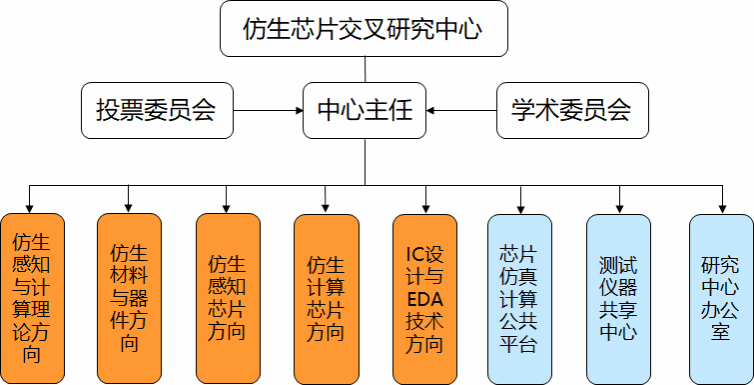
图3 中心组织架构
Figure 3 the organization of the center
The center organizes laboratories with professors as the unit, and collaborates with scholars from academic and industrial fields both inside and outside the school to create a dynamic combination of research centers. The organizational structure is shown in Figure 3.
The current director of the center: Dr. Gao Wu, a full-time professor, whose research direction is: bio-inspired sensing and computing theories, intelligent computing architecture and chips, integrated circuit design, radiation electronics, etc.
4. 中心近期进展
4. Recent Progress of the Center
4.1 实验平台建设
4.1 Experimental platform
在学校双一流经费的支持下,已建设仿生芯片计算平台、仿生芯片电测平台、仿生芯片晶圆级测试平台等硬件和EDA设计软件平台,具备独立从事仿生芯片研发的能力。
With the support of special funds from the university, hardware and software platforms such as EDA computing platform, electrical testing platform, and wafer level testing platform for bio-inspired chips have been built, possessing the ability to independently R&D of bio-inspired system-on-chips.
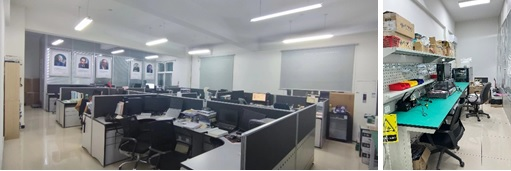
图4 仿生芯片实验平台
Figure 4 Experimental platform for bio-inspired chips
4.2 科学研究
4.2 Scientific research
2021年以来,承担了国家自然科学基金重点项目、特色学科基础研究项目、陕西省重点研发计划“揭榜挂帅”项目等5项,开展了仿生视觉处理器、感存算一体化芯片、仿生嗅觉/味觉芯片、群智计算芯片等方向的科学研究,初步探索了仿生感知和仿生计算融合的硬件架构,研制了多款原型芯片。
Since 2021, we have undertaken five key projects including the National Natural Science Foundation of China, the Basic Research Project of Characteristic Disciplines, and the Shaanxi Provincial Key R&D Plan's "unveiling and commanding" project. We have conducted scientific research in the fields of bio-inspired visual processors, in-sensor computing integrated chips, bio-inspired olfactory/taste chips, and swarm intelligence computing chips. We have preliminarily explored the hardware architecture of the integration of bio-inspired sensing and bio-inspired computing, and developed multiple prototype chips.

图5 仿生计算芯片架构
Figure 5 the architecture of a bio-inspired computing possessor
4.3 人才培养
4.3 Education
中心目前有教师3人,其中教授1人,副教授1人,助理教授1人。中心成立以来,吸引了计算机学院、微电子学院、电子信息学院、航空学院等不同学科的学生加入,现有在读研究生20人,其中博士生8人,硕士生12人,开展了多学科交叉复合型研究生培养。
The center currently has three teachers, including one professor, one associate professor, and one assistant professor. Since its establishment, the center has attracted students from different disciplines such as the School of Computer Science, the School of Microelectronics, the School of Electronic and Information, and the School of Aeronautics. There are currently 20 graduate students, including 8 doctoral students and 12 master's students. It has carried out interdisciplinary and composite graduate training.
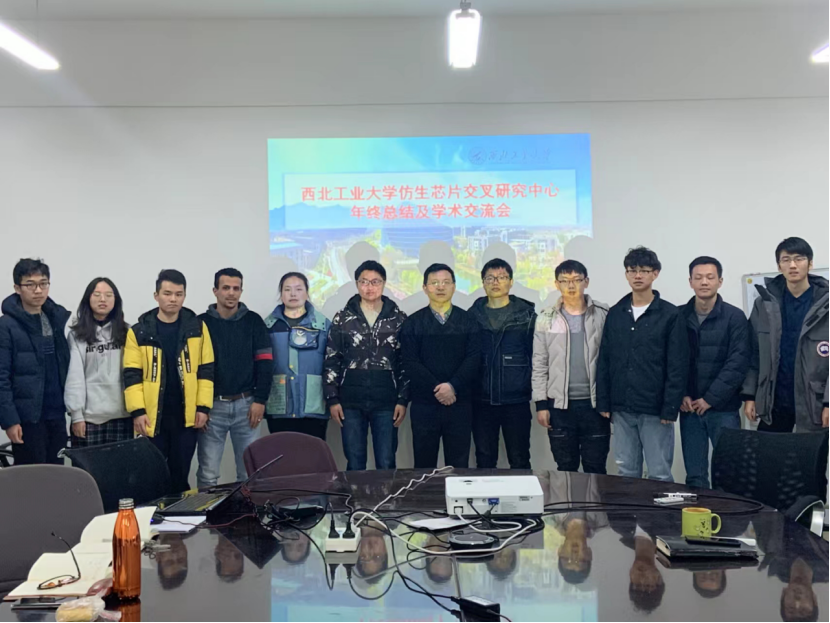
图6 在读学生学术交流会
Figure 6 Seminar of current graduate students
4.4 学术活动
4.4 Academic Activities
先后组织了两期仿生芯片学术沙龙,邀请了清华大学、浙江大学、复旦大学、北京航空航天大学、西安交通大学及我校相关领域的老师与中心师生交流。
We have organized two academic salons on bio-inspired chips and invited professors and students from Tsinghua University, Zhejiang University, Fudan University, Beijing University of Aeronautics and Astronautics, Xi'an Jiaotong University, and related fields of our university to exchange ideas with the center.
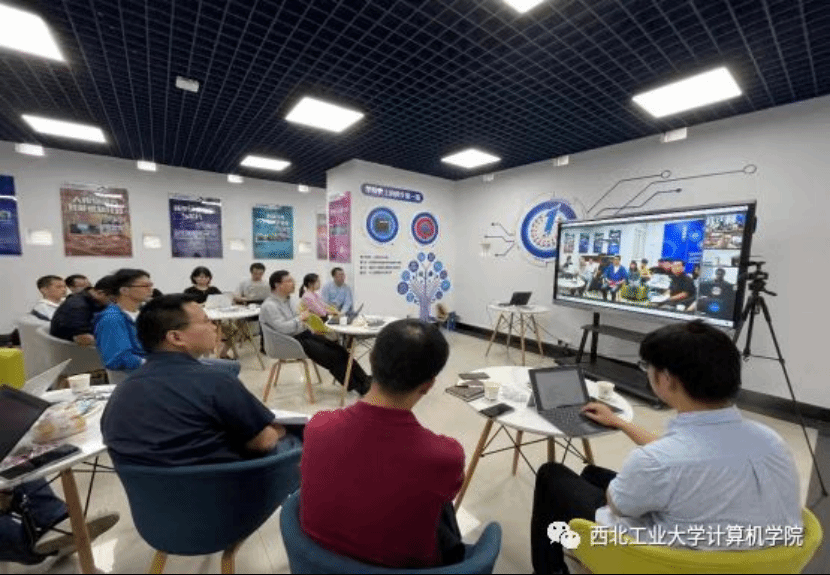
图7 仿生芯片学术沙龙
Figure 7 Academic salon of bio-inspired chips
5. 联系方式
5. Contact information
联系人:高 武 教授
Contact person: Professor Gao Wu
联系电话:029-88430219
Contact number: 029-88430219
电子邮件:gaowu@nwpu.edu.cn
Email: gaowu@nwpu.edu.cn
(数据截止2023年5月)
(Data as of May 2023)